Browse using the new Vinous website now. Launch →
Printed by, and for the sole use of . All rights reserved © 2015 Vinous Media
La Festa del Barolo 2016
BY ANTONIO GALLONI | SEPTEMBER 27, 2016
La Festa del Barolo 2016 was a rousing success. The event raised over $130,000 for charity and brought Barolo lovers from around the world together to celebrate the magic of Nebbiolo and Barolo in all of its different expressions.
This year’s Festa del Barolo was bittersweet as it was the last Festa to be held at the iconic Four Seasons Restaurant under the tenure of Julian Niccolini and Alex von Bidder. Since it first opened in 1959, the Four Seasons has played a central role in the life of New Yorkers. The space, designed by architects Mies van der Rohe and Philip Johnson, preserves the look and feel of a long-gone era, and yet the Four Seasons is also timeless in its elegance. Over the years and decades, the Four Seasons hosted many notable personalities and events before closing in July 2016 to undergo renovations before it reopens under the management of the Major Food Group.

Dinner in the Four Seasons’ iconic Pool Room
The Four Seasons also holds a special place for me personally, as it was the place I did many of my early tastings as a wine critic. I would duck out of my office next door at 345 Park Avenue and walk across the street to the restaurant, where I was allowed to sit in the corner and taste dozens of wines while patrons at adjacent tables enjoyed their Dover Sole or Roasted Duck in the Four Seasons' celebrated Pool Room. The Four Seasons Restaurant was a great friend to La Festa del Barolo. I would like to thank the entire staff for the support they lent our event over the years.
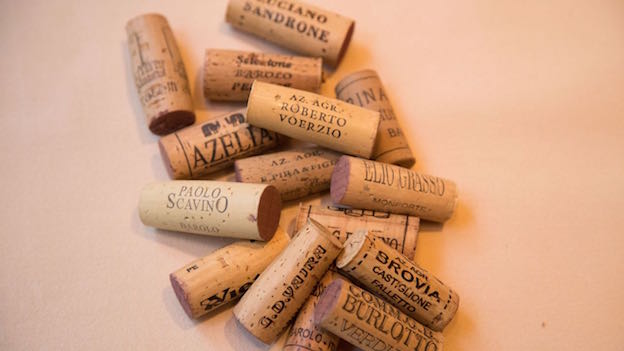
Fifteen estates were represented at La Festa del Barolo 2016
From start to finish, La Festa del Barolo takes about a year to plan and the work of many people to pull off. Fifteen producers traveled from Italy to share their wines. Our team of 50 sommeliers was drawn from restaurants across the United States. Del Posto’s Jeff Porter and our own Kelli White served as Head Sommeliers and made sure everything around wine service was flawless. Many other individuals worked behind the scenes to make sure everything came off perfectly. Your efforts are noted and deeply appreciated.
The Gala Dinner & Charity Auction
La Festa’s Gala Dinner & Charity Auction is inspired by Burgundy’s La Paulée, a traditional end of harvest celebration. Each grower presents two older vintages at their respective table. Guests are invited to share bottles from their own cellars with their friends, fellow attendees and producers in what is always a lively and convivial exchange of fabulous wines. The room is set with fifteen tables, one for each producer, plus a Vinous table for our guests.
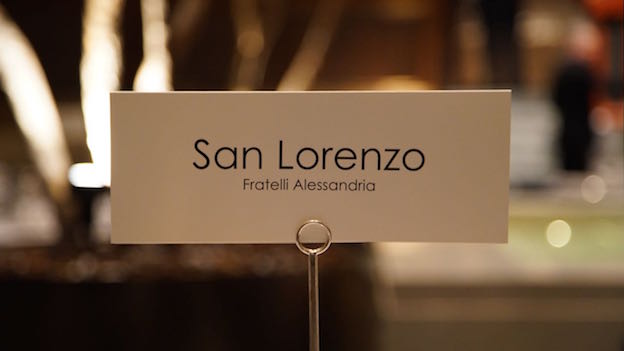
Fratelli Alessandria’s Gala Dinner Table
This year’s Gala Dinner got off to a roaring start. The feel in the Four Seasons’ Grill Room was immediately electric. We served three of my favorite Champagnes and a California sparkling wine with the hors d’oeuvres. The 2008 Cédric Bouchard-Roses de Jeanne Blanc de Noirs Côte de Béchalin, 2002 Dom Pérignon, NV Egly-Ouriet Extra Brut Grand Cru Vieillissement Prolongé and 2011 Ultramarine Blanc de Blancs Charles Heintz Vineyard were all terrific when I tasted them beforehand.
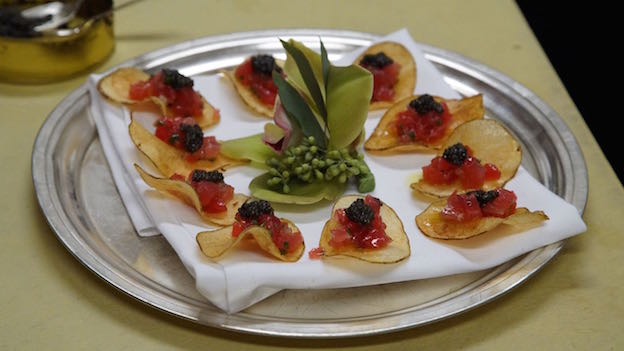
Tuna tartare; caviar, potato chip
Once again the Four Seasons and Executive
Chef Pecko Zantilaveevan did a terrific job with a delicious menu that
showed how well Nebbiolo pairs with a variety of different foods and
seasonings. The Asian duck consommé, Risotto with mushrooms and black truffles
and Braised Short Ribs with polenta, root vegetables and red wine sauce were
delicious and also very wine friendly.
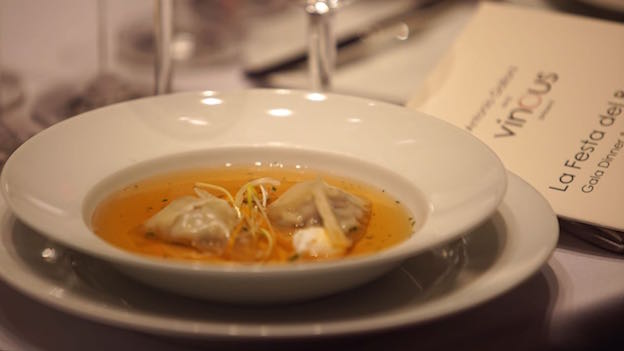
Asian duck consommé; poached quail egg, duck dumplings
La Festa’s Charity Auction, run by Jermaine Stone of Wally’s Auctions, included a number of rare wines, most of them impossible to find large-format bottles directly from the producers’ cellars. We added a 3L of Giuseppe Rinaldi’s 2009 Barolo Brunate-Le Coste and a 1.78L bottiglione of the 1955 Bartolo Mascarello Barolo from our cellar. This year’s Charity Auction raised over $130,000 for The Zone, a state-of-the art facility within The Mount Sinai Hospital that helps seriously ill children and their families cope with hospitalization.
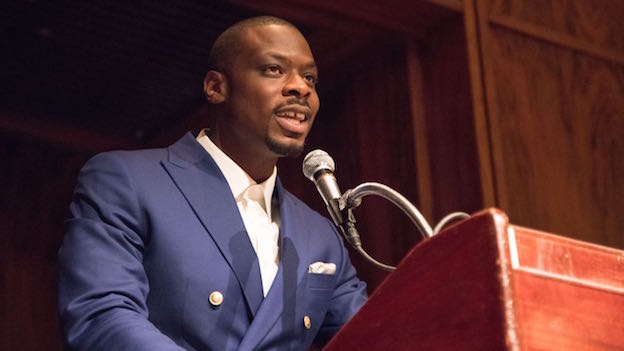
Jermaine Stone of Wally’s Auctions
The quality of the wines at dinner was just mind-boggling. Everywhere I looked, all I saw was reference point bottles left and right. The kind of wine any Barolo lover would be thrilled to taste, even just once. That point was driven home the following day when I returned to take photos of some of the empties. One table enjoyed a stunning collection of magnums. Older, rare wines were all over the room. These are a few of the wines I had a chance to taste. As always, Barolo likes a little company. Most often it comes in the form of Barbaresco, Champagne and Burgundy. Who am I to argue?
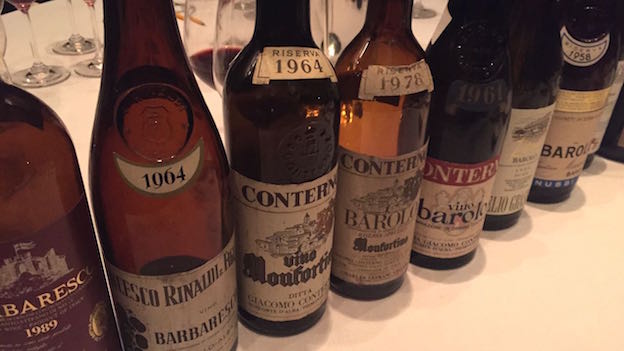
An embarrassment of riches
Roederer’s 1979 Cristal comes early in the evening. What a monumental wine. I remember a 1979 vertical a few years ago and how tremendous the 1979 was that night. The 1979 has been exceptional in several recent tastings. On this night, it is magnificent. La Festa del Barolo is off to a brilliant start. The 1959 Dom Pérignon Oenotheque is sublime. Silky, nuanced and exquisitely layered, the 1959 is haunting in its beauty. Moët & Chandon’s 1962 Vintage is another superb Champagne. Dense, powerful and intense, especially for a wine of its age, the 1962 offers plenty of dried pear, smoke and slate nuances, not to mention tons of personality.
White Burgundy is up next. A magnum of Domaine de la Romanée-Conti’s 2005 Montrachet is terrific. This is one of the better examples of the 2005 I have had in recent years. Then again, the large format seems to be especially helpful in this vintage, where the wine has been inconsistent. The 2003 Montrachet, also from magnum, is once again quite impressive. A rich, phenolic wine, the 2003 almost feels like a red wine. Despite the torrid, brutally hot vintage, the 2003 retains considerable freshness, not to mention tons of pure depth. The 2003 is a fascinating wine to taste, as it appears to have handled the rigors of the brutal growing season admirably. Then the 1989 Montrachet appears. What a wine. Soft, delicate and gently mellowed by the passage of time, the 1989 is majestic, sublime and a real privilege to taste. The night could have ended here for me and I would have been content. Quite a bit more than content, actually. Tasting and drinking Coche-Dury’s 1995 and 1996 Corton-Charlemagne side-by-side is always fascinating. The 1995 is rich, tropical and exotic, with plenty of dried fruit and nutty overtones, along with soft contours that make it so expressive now. The 1996 Corton-Charlemagne, on the other hand, is tightly wound, crystalline and much more citrus and mineral-drenched in profile. Quite simply, the 1996 is about as good as it gets. It is also one of my all-time favorite wines.
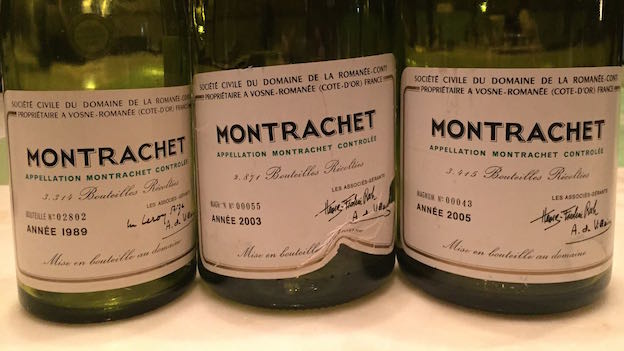
A collection of Montrachets from Domaine de la Romanée-Conti
A fine bottle of the 1985 La Tâche follows. The 1985 can be irregular at this stage, but this bottle is in terrific shape with plenty of signature exotic spice, star anise, rose petal, dried cherry, along with silky tannins to match. The 1985 Richebourg, also from DRC, is quite good, although it doesn’t have the inner sweetness and silkiness of La Tâche. The fruit is now drying out, which, among other things, makes the tannins stick out a bit. Dujac’s 1993 Clos de La Roche is powerful, deep and explosive, with superb balance and tons of pure, unbridled intensity. Savory and mineral to the core, the Clos de La Roche captures the essence of this great vintage. What a wine. Readers lucky enough to own the 1993 can look forward to another two decades of fine drinking. In this context, the 1996 Clos de La Roche comes across as shockingly young, raw and nowhere near ready to drink. High in both tannin and acidity, the 1996 is years away from offering its best drinking.
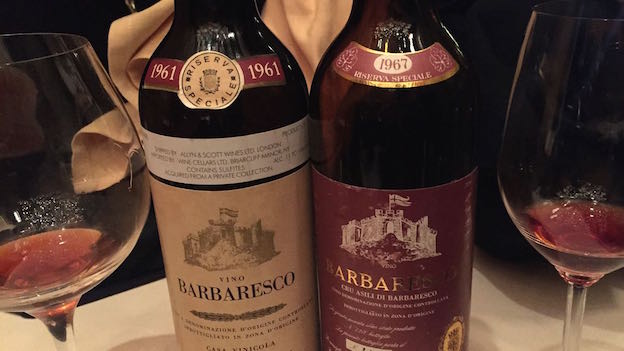
Two early masterpieces from Bruno Giacosa
Even with all those wines, the main event is Nebbiolo. It’s a real pleasure to share my last bottle of Bruno Giacosa’s 1967 Barbaresco Riserva Speciale Asili with a group of dear friends. I have had the 1967 many times. While the 1967 is often terrific, I have never had a bottle that rivals Giacosa’s two most epic 1960s Barbarescos – the 1961 Riserva and the 1964 Santo Stefano Riserva. Specifically, the 1967 has always been less pure. This bottle, though is simply magical. Translucent, weightless and sublime, the 1967 is superb. We taste it next to Giacosa’s 1961 Barbaresco Riserva Speciale, which remains one of the greatest wines I have ever tasted from any region. The cranberry, orange peel and spice nuances are exotic and utterly beguiling. Both wines exemplify what fine, aged Nebbiolo is all about. A pristine bottle of Giacosa’s 1985 Barbaresco Riserva Santo Stefano is next. Sweet, perfumed and exceptionally polished, the 1985 is a real head-turner. At the same time, this bottle and other recent examples suggest the 1985 is starting to fade into full maturity.
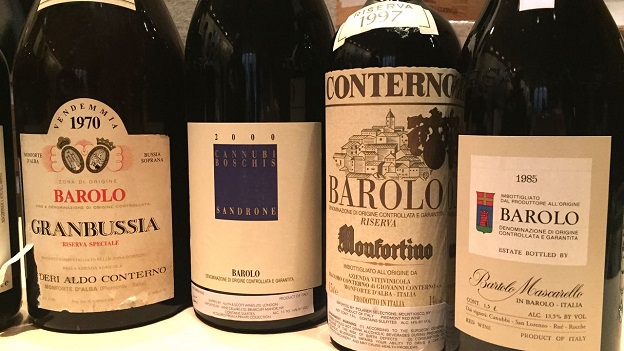
This table prefers big bottles
I was fortunate to start buying Beppe Rinaldi’s wines before they
became the objects of desire they are now. This magnum of the 2001 Barolo Brunate-Le Coste, from my
cellar, is off the charts. Rich, deep and towering with its structure, the 2001
is a reference-point Barolo that beautifully expresses the virile personality of
this grand cru site. Tasting Rinaldi’s 1999
Barolo Brunate-Le Coste is like running into a long-lost friend. Some time
has passed since I last tasted the 1999, and yet there is an instant
familiarity. Powerful and tightly wound, but finally showing something, the
1999 is a tremendous old-school Barolo. Readers who own it should be ecstatic.
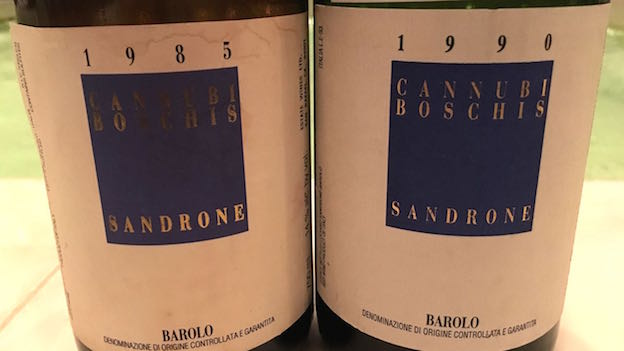
Two fabulous Barolos from Luciano Sandrone
Luciano Sandrone’s 1990 Barolo Cannubi Boschis is an epic wine that also introduced many new consumers to the joys of Piedmont twenty years ago, when it was first released. Every bit as magnificent today, the 1990 is rich, radiant and intensely dark, but also softened through the passage of time. What a gorgeous wine it is. In its first vintage, the 1990 Barolo Le Vigne shows a bit more of a red-toned profile (rather than the blue/purplish fruits found in the Cannubi Boschis), along with fabulous energy and freshness for a wine of its age.
Sandrone’s 1985 Barolo Cannubi Boschis is one of the wines of that vintage. All of these years later, the 1985 Cannubi Boschis is still a tremendous wine endowed with superb
depth for a Barolo of its
age. I imagine the 1985 was probably a shockingly rich wine when it was
made more than thirty years ago. Today, it shows a young Luciano Sandrone just
tuning in the style that would later make him so celebrated the world over. Vietti’s 1985 Barolo Rocche is another
treat. Powerful and intense, with notable freshness for the year, the 1985 is
yet another wine I feel lucky to taste. Many thanks to the Vinous reader who
shared it!
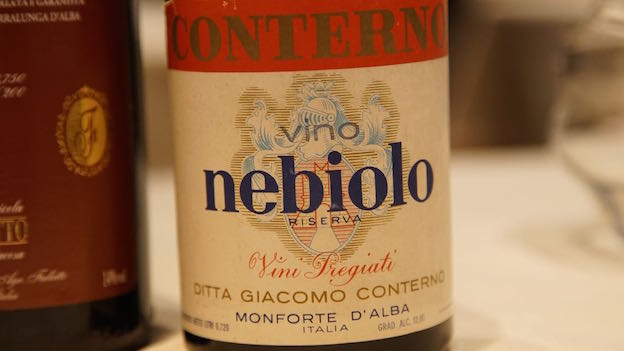
Giacomo Conterno’s super-rare 1964 Nebiolo Riserva
The Giacomo Conterno wines include the 1964 Nebiolo Riserva, a bottle I bought some years ago. I confess I don’t know much about this wine. But Roberto Conterno did not know much about it either when I asked him about it a few days later. No matter, the wine is superb, delicate and striking in its beauty. As for the empty bottle, it was rare enough for someone to grab it off our table without asking. The 1987 Barolo Riserva Monfortino, also from my cellar, is hauntingly ethereal and gorgeous. I could have spent the entire evening with the 1987 Monfortino. A wine from a long-forgotten, rainy vintage, the 1987 has long been a super-sexy and relatively accessible Monfortino. It is all that, and more on this night. The 1978 Barolo Riserva Monfortino is everything it has always been. Epic, dense and towering in its intensity, the 1978 remains one of the greatest wines ever made in Piedmont. That’s pretty much all there is to it.

Braised short ribs; polenta, root vegetables red wine sauce
I don’t imagine there are too many bottles of Giacosa’s 1978 Barolo Collina Rionda Riserva left. I have often wondered: “What did the 1978 taste like when it was first released?” I am too young to know the answer. Even today, at nearly forty years of age, the 1978 remains one of the greatest wines Bruno Giacosa ever made. Deep, layered and sensual to the core, the 1978 balances the power of the vintage with the refined personality of Rionda like few wines have before or since. Dried rose petal, spice and tar notes round out this uber-classic Barolo from Bruno Giacosa.

A bevy of Giacosa Red Labels
Mauro Mascarello’s 1982 Barolo Monprivato remains one of my all-time favorite wines from this reference-point estate. Still fresh, perfumed and beautifully focused, the 1982 retains striking power to match its penetrating aromatics and flavors. This is another of the many highlights of the night. The 1978 Cogno-Marcarini Barolo Brunate is another rare, rare bird. Still deep, the 1978 is a picture perfect example of Brunate as interpreted by the late Elvio Cogno. It is one of the many wines I tasted that would have been the highlight of any other evening. But at La Festa del Barolo, many wines share the limelight.
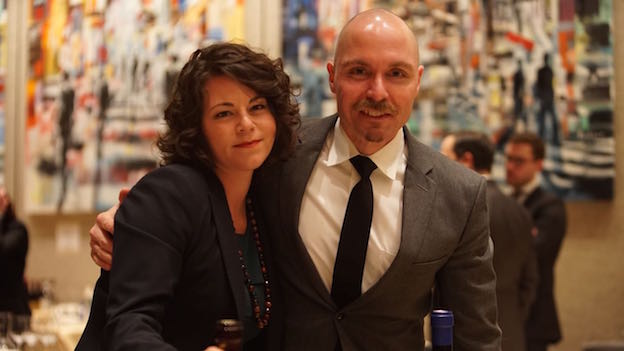
Sommeliers Liz Nicholson and Henry Davar
2011 Barolo Masterclass: The Here and Now
Over a hundred Barolo enthusiasts gather the following morning in the Pool Room for a survey of the 2011 Barolos. I don’t think it is an exaggeration to state that this is the most experienced and savvy collection of Barolo lovers ever assembled in one place. As I look into the audience, I see at least 5-6 people who could easily moderate this panel, including our own Ian D’Agata.
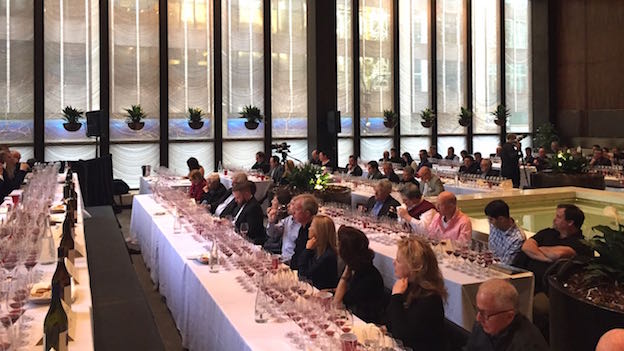
The audience listens with rapt attention as producers discuss the 2011 Barolos
All of the wines are opened 2-3 hours in advance. Luckily there is a very low incidence of corked bottles. I am not a fan of pre-pouring for tastings like this, so the wines are poured as we go. The sommelier team does an excellent job in making sure every wine is served and tasted under optimal conditions. Each producer comments on their wine, after which a spirited Q&A session takes us into lunch.
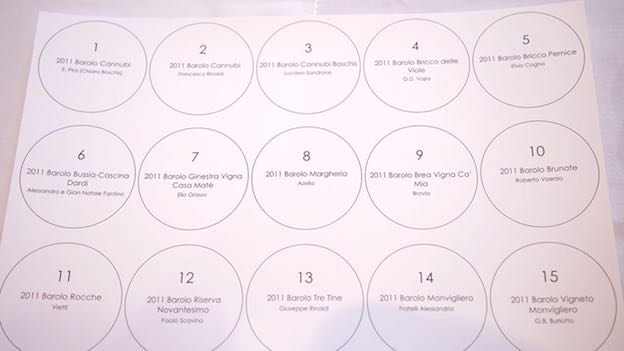
2011 Barolo Masterclass tasting mat
I can’t say I am surprised by any of the 2011s, as I have followed them since the harvest. Instead, it is the finesse of the year that is most striking. Two thousand eleven saw consistently dry conditions and higher than average temperatures for most of the growing season and yet the wines are all quite aromatic and delicate. The 2011s don’t have the roasted quality or hard tannins of the 2003s nor the sheer opulence of the 2007s. They are in general more restrained wines. I have heard a number of explanations for this. Some producers believe the vines have gotten accustomed to the more frequent occurrence of warm vintages. Others say that it is shocks that trouble vines more than anything else, and 2011 was not a vintage of shocking heat (like 2003), but rather a year of elevated temperatures that started in the spring and continued for much of the year, with the exception of a period in the middle of the summer when temperatures cooled off before rising again in the weeks leading up to the harvest. My major critique of the 2011s is that vineyard signatures aren’t as crisp as they are in less extreme vintages. As for the wines themselves, they are quite attractive, especially at this high level.
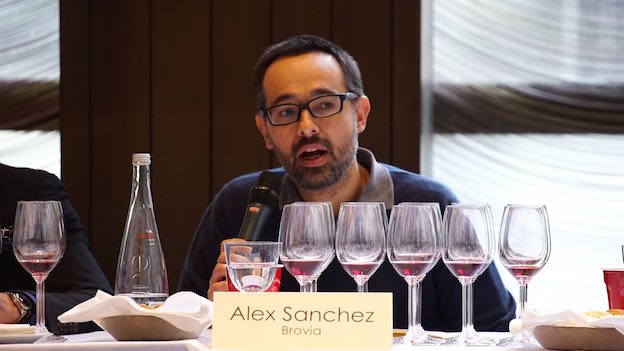
Brovia’s Alex Sánchez during the 2011 Barolo Masterclass
Barolo & Burgers Lunch
Continuing in what has become something of a tradition over the last two years, we move into the Grill Room for an informal, American-style lunch as guests finish the rest of the 2011 Barolos. It’s a great way to wrap up the event.

The Four Seasons’ burger pairs beautifully with Barolo
La Festa del Barolo returns to New York on February 3 and 4, 2017. Full details will be announced shortly.
You Might Also Enjoy
2012 Barolo: Grace Under Pressure, Antonio Galloni, March 2016
2011 Barolo, Part 2 (Late Releases), Antonio Galloni, December 2015
La Festa del Barolo 2015, Antonio Galloni, April 2015
2011 Barolo: The Here and Now, Antonio Galloni, March 2015
2011 Barolo – A First Look, Antonio Galloni, September 2014
La Festa del Barolo 2013 Gala Dinner, Antonio Galloni, March 2014